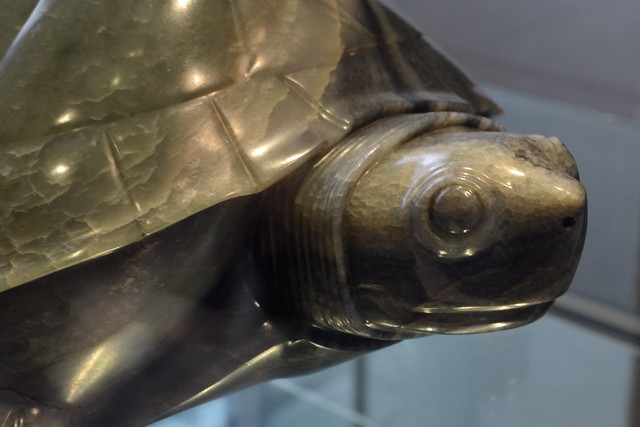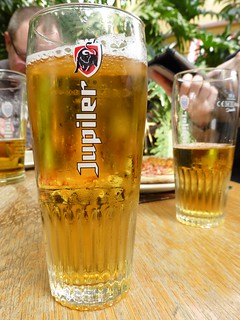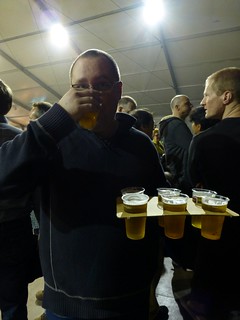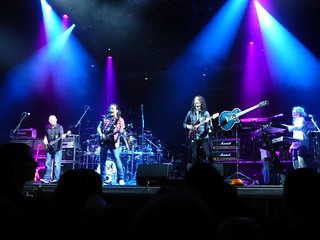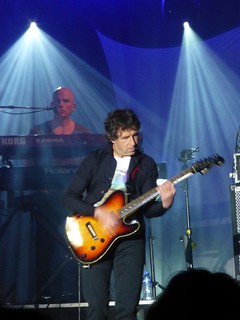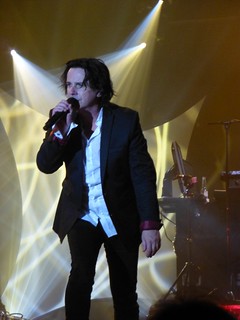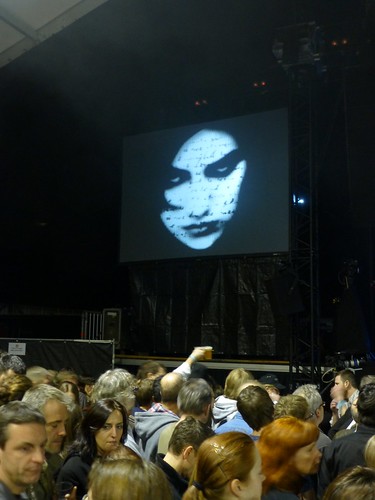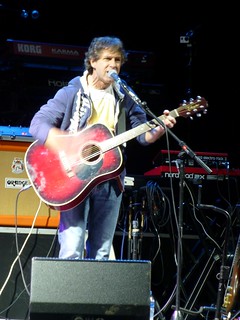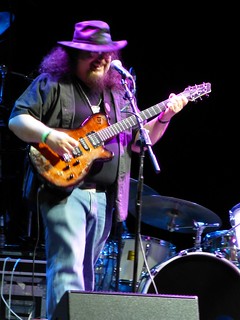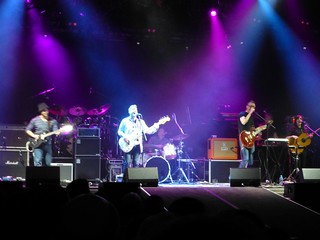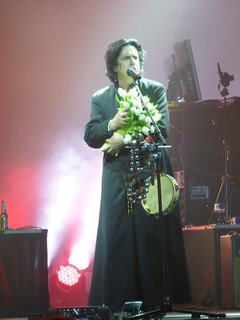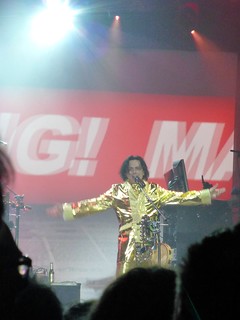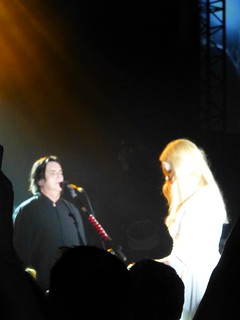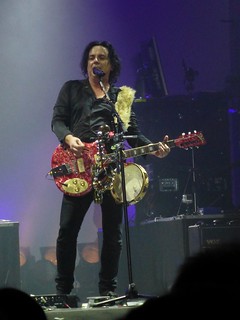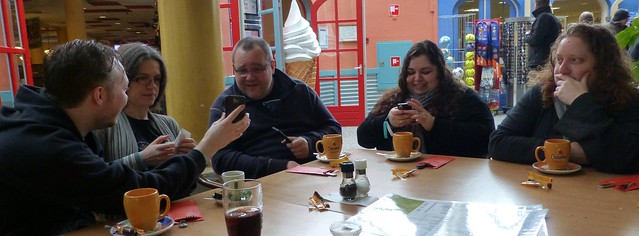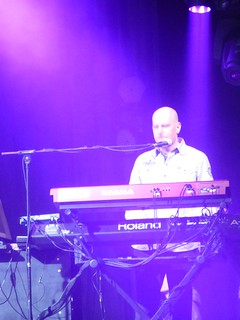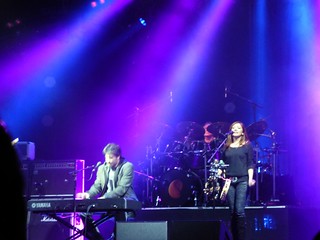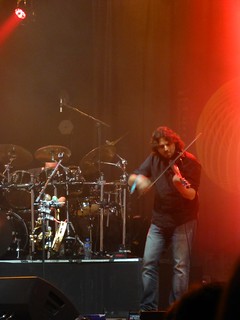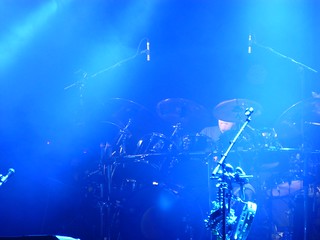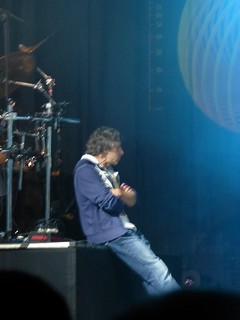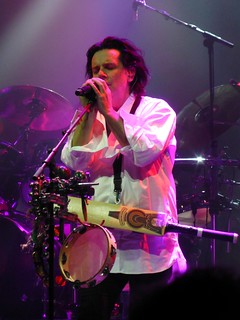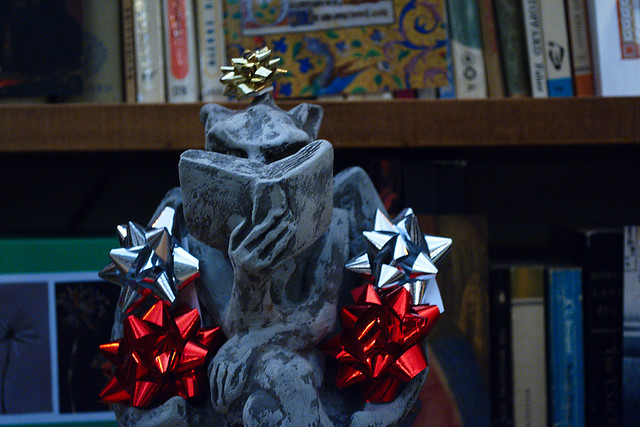A History of Syria with Dan Snow; Howard Goodall’s Story of Music
Instead of starting TV night with our on-going series, we started with a documentary about Syria – watching it first because it was bound to be depressing viewing. A History of Syria with Dan Snow was a This World documentary that looked at the historical underpinnings of the current civil war, to put it into some sort of context. I’m sure I’m not going to manage to get everything right in my summary and being a current & politically charged subject I’m more conscious that errors may offend, I’ll still try & give some sort of feel for what Snow told us.
He started with a little bit of geography – showing us where Syria is on the map, and pointing out that it’s at the point of contact between Asia, Europe & Africa. So trade flows through the region, and empires butt heads across the region. In some ways the 5000 year history of the region could be summed up as “the Syrian people got screwed over by one big empire after another”. Snow only name checked the Egyptians & Assyrians, and got down to business properly with the Romans. Syria was a wealthy province under Roman rule, due to its location and the trade routes running through it. And the people converted to Christianity when the rest of the Empire did (if not before) – Syria was an important centre for Christianity until the Muslim conquest, and there is still a sizeable Christian minority in the region to this day. Snow visited a church service in Damascus, and talked briefly to a priest afterwards who was keen to stress his view that all Syrians were important regardless of religion, sect, ethnic background. Which was an optimistic way to start the programme.
Syria became part of the expanding Muslim empire very early on and then the capital of the (Sunni) Umayyad Caliphate was in Syria. The majority of the people living in Syria today are Sunni Muslims, and Snow said that the time of the Umayyads is looked back to as a kind of golden age for Syria by the Sunnis. He skipped lightly over the next few hundred years when Syria was first ruled over by an Egyptian centred Muslim empire, and then by the Ottoman Turks. The only key point from this era that he mentioned was the Crusades & the way they have shaped Arab feelings about Western intervention in the region. The next period he discussed in depth was the British Empire’s turn at screwing over the Syrians – this was during the First World War when the British allied with the native Syrians as a way of destabilising the Ottomans. This is the time of Lawrence of Arabia, and the war ends with the Arabs convinced that the British have promised them their own independent state – only the British had also promised most of the territory to the French & guess which promise gets kept? The French rule over Syria was imperialist & brutal, and there was a rebellion (which ultimately failed) in 1925. Snow talked to the daughter of the man who lead that rebellion & she talked about how she feels the current rebellion is the spiritual successor to her father’s rebellion.
Syria became independent in the 1930s, and the programme skipped lightly over the next period until we get to the seizing of power by Hafez al-Assad – but first it back-tracked to explain another bit of older history that is important to put this into context. Most of the Muslims (and indeed most of the people) in Syria are Sunnis, but the largest minority group is a Shia Muslim group of people called the Alawites who make up about 12% of the population of Syria. The division between Sunni & Shia Muslims goes back to immediately after the death of the Prophet, and has continued ever since. In Syria (and the region around Syria) the Alawites have been particularly persecuted – Snow was telling us that almost within living memory members of this group were unable to find work because of their religion. Assad was an Alawite, and rose to prominence via the military at a time when the Ba’athist political party were gaining in strength. Through two military coups (first that put the Ba’athists in power, then that put Assad himself in power) he took control of the country. Snow interviewed a Ba’athist political figure, a woman who is an advisor to the current government and was an advisor to Hafez al-Assad’s government. She emphasised the secular nature & policies of the Ba’athist party, dwelling on how Assad put schools into all the villages, and that women could get an education. What she didn’t mention was that the Assad regime was a tyrannical police state. Snow also interviewed a couple who had lived in Hama, a Syrian town, during the 1982 massacre that the government perpetrated there – theoretically to quell Muslim Brotherhood led insurrection, but actually tens of thousands of civilians were killed.
Assad’s Russian connections were also important – during the 60s he’d been an army leader at a time when Israel was flexing her muscles. And he gained a reputation as an Arab strongman, who’d helped the Arab world to recover it’s pride after defeat by Israel. I’m fairly unclear on the details of this bit to be honest – but the take home message was that Assad’s regime had both the backing of parts of the Arab world, and the backing of the Soviets as a counterpoint to the US backing of Israel.
So that’s almost all the pieces of the situation lined up – the last bit that’s needed is that once Hafez al-Assad died, his son Bashar inherited the presidency. He seemed at first to be likely to reform the police state nature of the Syrian state, and hopes were high that he’d move the regime towards a more open & democratic (and Western-friendly) state. But this was not the case, and he continued with his father’s policies – and methods.
The Arab Spring of 2011 was then the spark that lit the tinderbox. Snow’s interview with the couple from Hama also talked about this – they and their sons had been involved in the first protests, but are now living as refugees away from the fighting in Syria. One of the sons was saying that at first the protests were about wanting democracy, then once people started being killed it was about overthrowing the regime. The programme then cut back to the woman in the government who was saying that they had reacted to armed insurrection the way any government would – that the rebels were preventing the normal business of the country so the army had to be sent in to protect the state. With interviews with people on both sides of the conflict Snow showed that however it started it’s fragmented down the fault lines that history has provided – Sunni vs Alawite, secular vs religious, to name a couple. With the ordinary people being caught in the middle of it.
Sobering to watch – it seems like a situation where there’s so much history and ill-will on both sides both recent and dating from centuries ago that it’s hard to see how it can be resolved.
To follow that up, we watched the fifth episode of Howard Goodall’s Story of Music as something lighter weight to cheer us up before sleep! This was titled “The Age of Rebellions” and covered the period from the death of Wagner (in 1883) through to just before the First World War. Goodall opened by talking about how after the death of Wagner instead of several pseudo-Wagners continuing on with his style of music instead you have a movement away from a Wagnerian style – rebelling against it, if you like. Goodall seemed quite gleeful about this 🙂 So we heard some bits from Satie, Faure and other French composers of that era. Goodall also talked about Mahler in this segment & discussed how his symphonies & songs were a move to a more personally emotional music. Rather than writing some abstractly sad piece & calling it something general like “Nocturne” Mahler wrote songs about specific subjects like the death of a child.
Another of Goodall’s themes for the programme was the influence that folk music had on the classical music of the time – Mahler, for instance, incorporated the sounds & rhythms of the Jewish folk music of his upbringing. It was in Russia where this was a really striking trend. Previously Russian music had looked to the West rather to its own traditions of music, but in the late 19th Century this was to change. One of the major players in this change was Mussorgsky – and his music was different because he was not formally trained, and so didn’t know the “rules” that he was busy breaking. Not all of the composers influenced by Mussorgsky were Russian – Debussy heard Mussorgsky’s music at the World Fair in Paris. Debussy was also influenced by other music he heard there, like the Javanese musicians, and he incorporated these non-Western rhythms & tonalities into his music.
This breaking of the previous rules for composing music encouraged others to experiment even further. The ballets of Stravinsky (like Firebird & the Rite of Spring) with their overlayed rhythms & polyrhythms were a result of this experimentation, as was the dissonance & emotionality of Strauss’s opera Salome. We were shown a little of Salome & I don’t think I’ve any desire to see the whole opera 😉
The last segment of the programme was devoted to the new mainstream music that was beginning in this era – the blues and later ragtime and the beginnings of jazz. Goodall talked about how the blues and the spirituals grew out of the African-American’s musical traditions, both from the music that they remembered from their African origins & the Christianity they were converted to once in America. Goodall said it was controversial to suggest that there were any other influences on this music, but that he believed there were also traces of the music of European immigrants (in particular railroad workers) and also the Chinese railroad workers.
As this new music became more mainstream classical music began to decrease in popularity. Goodall told us that the reaction of classical composers was to write music that appealed to a sense of nostalgia. The music of Elgar is a part of this nostalgic music. And the programme ended with Goodall pointing out that this nostalgia was for the sort of elite lifestyle that was just about to end with the outbreak of World War I.
“China: The World’s Oldest Civilisation Revealed” John Makeham (Part 6)
Great Changes: The Tang-Song Transition (Second Half)
This is the second half of the chapter on the Tang & Song dynasties & it covers the Song Dynasty and the Mongolian Yuan Dynasty. The time period covered is from 960AD through to approximately 1370AD.
Orientation Dates: Mostly English history for these, plus the dates of some of the Crusades. 1066AD is the Battle of Hastings. First Crusade was 1095AD to 1099AD. “The Anarchy” was between 1135AD & 1155AD (post). Third Crusade (Richard Lionheart & Saladin) was 1187AD to 1192AD. Gerald of Wales lived at the end of the 12th Century (post). Fourth Crusade (and sack of Constantinople) was 1202AD to 1204AD. Magna Carta was signed by King John in 1215AD. Edward I conquered Wales between 1277AD & 1283AD. Hundred Years War started in 1337AD. Black Death arrived in England in 1348AD.
The Northern Song
Like many of the Chinese ruling dynasties the Song Dynasty is split into two parts – first the Northern Song, then the Southern Song. The Northern Song started by re-unifying most of the country, all but the most northern parts of what had been China under the Tang Dynasty. Unfortunately the book didn’t give me a map of this, so I had to resort to looking it up in another book. They (again like the immediately preceding dynasties) tried to change the military focus of the culture – during the reigns of the first two Emperors of this dynasty (about 40 years from 960AD to 997AD) the military was overhauled and put under the control of civilian officials at the top level. The Emperors also made the civil bureaucracy more important by presiding as the final examiners who appointed all the bureaucrats. This lead to problems later in the dynasty – by the end of the mid-Northern Song period (around 1085AD) the elite regarded themselves as co-rulers of the empire and bureaucratic factionalism weakened the power of the dynasty.
The threats from the north of China (see below) meant that despite backing away from military rule the Northern Song had to maintain a large army. This in turn meant that higher taxes were necessary to pay the military expenses (and to pay tribute to the northern peoples), and there were attempts to reform the tax system to make it more efficient. These reforms seem to have been poorly implemented and as they often went against Chinese tradition (for instance by trying to employ specialised bureaucrats rather than follow the Confucian ideal of generalists) they ultimately failed which wasn’t good for the long term prospects for the dynasty.
Despite all this the Northern Song dynasty was a time of economic growth, and of a cultural renaissance. The economic growth partly came from properly integrating the south of the country into the economy for the first time – farming with new crop varieties that grew well there, and by improving the Sui canal system to integrate the nearer south with the northern heartlands. Maritime trade was also a growth area, and was particularly important as the country was now cut off from the Silk Road due to losing their more western provinces. The increased maritime trade lead to better ship building, and better maps – which could be up to the standards of the 19th Century maps of the Western world. Some southern cities had large colonies of foreign merchants within them – from places such as India, Arabia and Persia. The book says that this was a time almost of an industrial revolution, again comparing to 19th Century in the West (in this case saying that coal production was on similar levels to 19th Century Britain).
And shortly after discussing the trade with outsiders the book says “China looked inward during the Song Dynasty, and so remained isolated from the rest of the world”. Which doesn’t seem to add up, to me. This is used to lead into discussing the art of the Song period – which was more focussed on realistic depictions of nature than was previously the case, although increased realism doesn’t mean that there weren’t also symbolic constraints on how you depicted things. This time period was also the time when Neo-Confucianism flourished.
The Khitan (Liao) and Jurchen (Jin)
So the Northern Song never managed to whole re-unify what had been Tang China. During this time (960AD through to 1125AD) the people in the north were ruled by the Khitan – who were a northern tribal group of pastoral nomads. They conquered some of the Chinese settlements in the north and became increasingly Sinified in their rule over them – although the majority of their society stayed nomadic. The rulers even took a dynastic name, the Liao dynasty, and attempted to conquer Song China. This failed, but the resulting peace treaty in 1005AD involved the Song paying the Liao tribute.
In 1125 the Liao rule of northern China was supplanted by a new wave of nomadic tribesmen from the north. These were the Jurchen, who first conquered the Liao and then before they were even finished doing that they started to invade Song China. In 1127 they succeeded in taking the Northern Song capital and pushing the Song rulers back into southern China – this was the end of the Northern Song and the start of the Southern Song.
The Jurchen rulers took the dynastic name Jin and ruled over the northern part of China for a bit over a hundred years, until the Mongols displaced them in 1234. At first they were the rulers of the territory via the same officials who had ruled the districts under the Liao or Song administrations. But the Jin encouraged the Jurchen people to move into their new territory, and gradually came to directly rule the region. Over time they became more Sinified – partly as a deliberate act of policy by the ruling Jin designed to reduce the importance of the traditional Jurchen elite. This was then reversed by later Jin Emperors, and the various competing reforms reduced the military power of the Jurchen people. The book makes it clear that this was another large & prosperous empire, on a par with the Southern Song – they were trading partners despite occasional conflict and neither could defeat the other.
The Southern Song
As so often with this book, a map would’ve helped at this point. The Southern Song was a period when Chinese power was confined to the south of the country. The retreat, and loss of power, did nothing to stop the factionalism within the court. One minister, Han Tuozhou, even went so far as to start a war with the Jin, to discredit his opponents in the “peace” faction. This didn’t work out well for him – the Jin demanded his head (literally). And despite the fact that treating a minister like this was unprecedented for Song China they did indeed send his head off in a box, as requested.
During this era Confucianism was again reinvented to suit the current time. Neo-Confuciansim of the Northern Song period was forward looking & encouraged people to think for themselves. But during the Southern Song period a philosopher called Zhu Xi reinterpreted Confucianism with an emphasis on the authority of the teacher, and the authority of the old texts. Effectively doing what you were told became more important than thinking about what you were doing. During this time the exams for civil servants became the only way to become a part of the government (in contrast to previous eras when they were one path of many). And they became a test of moral orthodoxy as much as a test of talent.
The Mongol Yuan Dynasty
The Mongol tribes were united in 1206AD by Temujin – better known as Genghis Khan, the Great Khan. The Mongol armies then swept across large parts of Eurasia bringing them under Mongol control. This continued even after Temujin’s death in 1227AD and included the Jin territory in the north of China who were finally conquered in 1234AD. During the last part of their resistance they appealed to the Southern Song for help, but were refused. The inevitable conquest of the Southern Song was then delayed by internal Mongol politics, but completed in 1279AD by Kublai Khan’s forces. China was now fully re-unified for the first time in several hundred years – under the first Emperor of the new Yuan Dynasty, Kublai Khan.
The book concentrated on Kublai Khan and his dynasty in China, but also pointed out that he wasn’t just an Emperor of China. In fact a lot of his regime was tangential to China, he was trying to re-unify the Mongols and maintained a presence in Mongolia, Turkistan & Mongol Iran. And he was also keen on trying to conquer the other territories around China – like Korea, Japan, Burma & Java. To his Chinese subjects he was never anything other than a foreigner, as with his successors. And ultimately the Yuan efforts to conquer and control more territory weakened their rule in China.
Mongol ruled China was more religiously & cultural diverse than previous regimes had been. The Mongol elite brought other customs to the Chinese court, and patronised different religions to their Chinese predecessors. Tibetan Buddhism was one of these that rose to greater prominence during Kublai Khan’s reign. Art and literature were influenced by styles from other parts of Mongol ruled territory, and in turn Chinese styles influenced other parts of the world. During this time period blue & white porcelain became the first international art craze, prized across a large part of Eurasia, including parts of the West. Other cultural exchanges included the sciences – medicine & astronomy for instance – and even food. I was particularly struck by an aside about the food – when we go to eat at Mizu in town we often have gyoza as a side dish. These apparently derive from a Russian dish – piroshky – which entered Chinese culture during the Yuan dynasty period. I’d always thought of them as oriental. Trade occurred across the whole of Mongol territory, and beyond, which boosted the Chinese economy. Trade in the Jin and Southern Song territories had been mostly internal or between the two empires, so this greater market for their goods (and to buy goods from) revitalised the economy.
This is the time period when Marco Polo visited China. If he existed and actually visited China, that is. This book is firmly on the side of him being legit, but I’m sure we listened to an In Our Time on Marco Polo (which I don’t appear to’ve written up, must’ve been a while ago). And the experts on that programme were more inclined to think that he might’ve been a useful fiction to make a description of China more readable. Anyway, if he went, it’s Kublai Khan’s court he went to. And if he didn’t go, someone still described (reasonably accurately, it seems) the court & land. There are other Western visitors to the Mongol court described – some of them in both Chinese & Western records, for instance a papal envoy called John of Marignolli. The papacy sent quite a few envoys, and missionaries, to China and other Mongol states at this time. This was the time of the Crusades, and they were hoping for allies against the Islamic countries.
The Yuan ruled China for about a century – Kublai Khan was the most successful Emperor and after him and his immediate successor there were a series of short-lived Emperors. The Mongol state discriminated against the descendent of the Southern Song region in particular, and Mongol citizens had more rights under the law than Chinese. Eventually after those short-lived, weak and ineffectual Emperors there was increasing rebellion in the south (called “banditry” by the regime but more political than that word implies). And the Yuan Dynasty came to an end in 1368AD.
Tangents to follow up on: Mongols, and the whole history of that northern region – it’s interesting how the history of China seems to involve a lot of “barbarians” sweeping in from the north & conquering or re-uniting China.
In Our Time: Romulus and Remus
The primary founding myth of Rome is the story of Romulus and Remus, which we know from written sources from the 1st Century BC. It’s clear that the story is older than that, but opinions differ as to how old it is. The three experts who talked about the myth & it’s origins on In Our Time were Mary Beard (University of Cambridge), Peter Wiseman (University of Exeter) and Tim Cornell (University of Manchester).
They opened the programme by giving us a recap of the basic form of the myth, which opens with Numitor and Amulius. Numitor is the true King of Alba Longa, but his brother Amulius usurps his throne and tries to ensure there are no true heirs left. He installs Numitor’s daughter as a virgin priestess to prevent her from bearing more heirs to Numitor’s crown, but despite this precaution she still gets pregnant. One version of the story is that the father of the children is the god Mars who appears in the holy fire as a phallus and impregnates her (which must’ve been a trifle disconcerting for the lass!). The children, Romulus and Remus, are exposed on the banks of the Tiber but instead of dying they are suckled by a she-wolf for long enough to be rescued by a shepherd & brought up. Skipping forward to when they become adults they return to the city of their birth, and once they realise who they are they overthrow Amulius and reinstate Numitor as King. Wanting a city of their own to rule (as Numitor doesn’t look like to die any time soon) they set out to found one. Because they’re twins there’s no obvious answer to which one’s in charge, so they ask the gods to give them a sign. Both see a sign that they think makes them ruler, and in most versions of the myth the arguments continue until Remus is killed (most often by Romulus himself, or by his orders).
That’s the bit I knew already of the myth, but the story continues. Once the city was founded Romulus (and Remus if he’s still alive) wanted to attract new citizens, so that they had people to rule over. And so they allowed refugees and asylum seekers to join their population – regardless of the reasons they were unwelcome at their place of origin. So not just political refugees, but also criminals or runaway slaves were welcome. Most of these people were male, which presented a problem for the proto-city and its ability to sustain its population. So Romulus tried to negotiate marriage agreements with surrounding settlements – but these were turned down on the basis that the citizens of Rome were the dregs of society. So Romulus held a festival and invited all these other settlements to it – they came, with their daughters as well. And then Romulus and the citizens of Rome abducted the women – this is the rape of the Sabine women (which is a phrase I’d heard, but I didn’t remember the story if I’d ever heard it). The other settlements were obviously rather annoyed, and went to war with Rome – most were easily defeated but the Sabines were not. At the height of battle in Rome itself the women (who had now had children with their abductors) appealed to both sides to stop fighting – on the basis that their fathers were killing their sons-in-law, and this was senseless. The two communities made peace, and merged with Romulus now ruling jointly with the Sabine King. The Sabine King later dies, under suspicious circumstances which some versions of the myth pin on Romulus. Romulus lives to a ripe old age, then rather than dying he vanishes – in some versions ascending directly to heaven.
So that’s the story, and then the programme moved on to talking about how old it was and what the Romans themselves thought about it. There are no texts before the 1st Century BC, so what evidence there is for the story being older is more tenuous and based on art. Beard presented a couple of different things – a generally agreed upon one, that there was a statue of Romulus and Remus erected in Rome in the early 3rd Century BC. So there must’ve been a version of this myth then. The other piece of evidence is a mirror from the 4th Century BC which has a design on it that is a pair of infants and a wolf. Beard said that she thought this was pretty good evidence for the existence of the myth at that time. Wiseman disagreed – saying that the design also includes the god Mercury who has no place in this myth but does in a different with with twins in (but no wolf). He also thought that the myth cannot be older than 300BC because that’s when Rome & Sabine merged as a historical event so thus the story must have been invented to explain that.
And then the three experts had a very robust (yet utterly courteous) disagreement about myth, story and the origins of stories. This was clearly a debate these three had had before, they were all aware of each other’s positions on the matter before they started. I’ll attempt to summarise – Wiseman holds the opinion that a story has a single point of creation and that this is a conscious act by a specific person, who is inventing the story in order to explain some event. Beard and Cornell on the other hand think that the stories grow out of older stories and change with time and with telling. That you can compare the writing down of the Romulus and Remus myth in the 1st Century BC to the Grimm brothers collecting old folk tales by going and listening to people telling them and then writing down a “definitive” version of a fairytale which is not necessarily the only or the original version. I’m with Beard & Cornell, personally – I don’t see why there can’t’ve been a Romulus and Remus myth dating back a long time into Rome’s history (perhaps growing out of something earlier), that later incorporated bits & pieces of other stories and events as they seemed relevant to the people at the time*. Yes, Wiseman is right that by definition there must be a first time a particular story is told – but how do you decide when it counts as this story and stops being that other story that’s got a lot of similar features.
*Worth noting that the lack of evidence is lack of evidence for both theories – pre-1st Century BC it’s an oral tradition and we have no way of knowing what exactly that was.
At the end of the programme they also talked about how the Romans thought about the myth, and about what it said about what the Romans thought about themselves. Cornell (I think) pointed out that the Romans often seem embarrassed about this myth – it involves a fratricide, and the earliest Romans are “riff raff”. So some Roman authors try and explain away these elements to sanitise it and make it more “suitable” for their great civilisation. And Beard talked about how it’s interesting that this myth makes Romans foreigners in their own city – and even the other founding myth (Aeneas fleeing Troy and founding Rome) is still a tale of refugees. And I think it was Wiseman who talked about how during the civil wars around the 1st Century BC there was a feeling that of course Rome was turning on itself because didn’t their city start with a fratricide and weren’t they doomed because of this.
Marillion Weekend 2013
Marillion Weekends are held every 2 years, and on March 8-10th was the 10th convention – J and I have been to every one of them so far 🙂 This year, as with the last 3, it was held at the Center Parcs at Port Zélande, in the Netherlands. The current format is the band play 3 gigs, one each on Friday, Saturday & Sunday, complete with support bands and a long set from Marillion. There’s also stuff during the Saturday & Sunday afternoons, including a pub quiz about the band where the final is the fan winners vs. the band. And Swap the Band where fans get to play on stage with the band in place of one of the band members.
As I said, J & I have been to all of these conventions, from the first one which was just an evening in a small club in Oxford (The Zodiac) in 1998. (At first they were more frequent than every two years, as well as smaller.) We’ve had a selection of different people join us over the years. This year there were seven of us in our group – me, J, Paul, Ady, Ellen, Avi and Gordon.
Photos are up on flickr, I’ve just put some highlights in this post. I only took the point & shoot camera with me, not my DSLR – too faffy to have the big camera in a gig, and harder to hold over my head to take the pictures. J took most of the photos of our group, btw.
Friday 8th March
My notes emphasise beer … funnily enough 🙂 Those of us coming by car (Paul drove himself, me & J and Ady from Ipswich) got up at brutal o’clock (ie 4am) and got to Center Parcs around 1330 local time, in time for lunch and BEER! 🙂 We met the others (who came by plane and shuttle bus) afterwards, while we were buying merch, then got settled in at the chalet before our dinner.
The evening’s concert started off with a set from DeeExpus (who we’ve seen support Marillion before). And as was the case then – I enjoyed the set while they were playing, but I still haven’t listened to the album at home.
And then it was on to the main act 🙂 Marillion came out and played through the whole of their album Radiation – which was released in 1998, so is 15 years old. I think it was the first album released after I’d got into the band, so I feel a trifle old now 😉 It’s an album that’s not had all that good a reaction from “fans in general” in the past, because the mix is thought to be a bit sub-par – but live the tracks have always rocked, so they’ve re-released it this year with a new mix. This set included several tracks I like live – and one that’s gradually becoming a favourite of mine: A Few Words for the Dead. Since they toured Sounds That Can’t Be Made h has been doing some playacting with a fake rifle during this song & it adds something to it, to me.
The second half of the set after a short break was very much the bouncy set of the weekend – and could’ve been designed for me. Several Fish era songs (including Script for a Jester’s Tear which is one of my favourite Marillion songs), and the h era songs included both Hooks in You and Cover My Eyes. I bounced up & down till my feet hurt, and sang so much my voice went a bit 🙂
Afterwards those of us that were staying out (me, J, Paul, Ellen & Ady) walked briskly to the Adventure Factory (yeah, that’s the name of the bit where the bar was) and got beer. There was a queue from hell for beer from the bar, so we won’t dwell upon that – aggravating tho it was, we did end up with a sufficient quantity of beer 😀 About 1am we headed back to the chalet and I think in the end we stayed up till 3am chattering away – only 22hrs since we’d got up in the morning!
Saturday 9th March
Funnily enough, I started the day with a mild hangover, can’t think why 😉 Didn’t stop me having a few beers during the afternoon – although perhaps it should’ve done coz the hangover came back for the evening, oops :/ Gave away the beer I’d bought at the start of the gig and drank coke for the rest of it – caffeine, sugar, liquid, perfect hangover cure, shame about the taste!
The first of the support acts was Pete Trewavas doing a “solo” set – I put it in quotes because he had someone whose name I forget come on stage with him for a couple of the songs. But it was all his own music, and mostly himself singing and playing guitar. He kept saying he was nervous, but it didn’t really show. And obviously he got a good reception, because he’s part of Marillion. The second support act were Sweet Billy Pilgrim, who I have to confess passed me by entirely. Pleasant yet un-memorable would be my take on them, but everyone else really liked them. Perhaps the previous paragraph explains it, and I just wasn’t in the right head space for the band?
The first half of Marillion’s set was a play through of the album Brave in it’s entirety. Previous conventions have normally done an album play-through on the Friday night, this is the first time we’ve had a whole album on the Saturday night as well. And this is the first time we’ve had a repeat of an album as well – they played Brave at the convention at Pontins back in 2002. Brave as an album is a pretty emotional (and bleak) piece of work – it’s inspired by a news story about a girl found wandering about on/preparing to jump from the Severn Bridge who refused to tell her rescuers who she was or why she was there. The songs on the album are possible stories for how she ended up there. To be perfectly honest, this is not one of my favourite Marillion albums. Everyone you talk to about it says it’s an album to sit down and listen to – lights off, volume up, read the lyrics, give it your full attention. And I don’t really interact with music that way – I stick it on as background, and sing along with the stuff I know or dance round the living room (depending how many people can see me …). So Brave passes me by a bit on record. It’s still a powerful experience live. And it’s enhanced when the band play it as a whole album because the stage show to go with it involves h acting out some of the bits as well as the music playing. So there were bits with a girl in a white dress (Jennifer Rothery, the guitarist’s daughter) lighting candles round h during an atmospheric bit, masked men pulling h off stage etc.
We’d known for weeks that Brave would be played on this evening, so we’d been speculating about what the second set would consist of – I was assuming (and asserting) that it’d be all the more emotional songs, to continue the theme. And I wasn’t entirely wrong, this was the evening they played Out Of This World complete with the film of the Bluebird crash – always an emotional moment. But they did play some other stuff like Warm Wet Circles which was more upbeat and bouncy 🙂
After the gig we split into two groups like the previous evening (tho not quite of the same composition – Paul had caught the lurgy so headed back to the chalet), and thankfully the queue for beer in the Adventure Factory was better managed this time and we got drinks quicker 🙂 (And I was feeling up to beer again!) We met up with Tim, who works with J, while we were there and after a few beers headed back to the chalet for more. Tim provided us with the weekend’s lasting joke, I think 🙂 While we were all sitting in the living room we heard footsteps on the top flight of stairs & all the lights dimmed. Tim said “who’s that? Beelzebub??” … given where people were, it had to be Paul letting his cold affect his masking of his dark powers 😉
Sunday 10th March
Started the day without a hangover, always a plus 🙂 We spent lunch in search of vegetables, but still failing to find much – always the problem at that Center Parcs, the food isn’t great. J also took charge of the camera over lunch because he’d noticed I wasn’t taking enough photos of the people we were with, so we have a few from this morning/afternoon.
Then it was off to the main tent for the afternoon – the temperature was dropping from the almost spring-like temperatures it had been down to the more arctic weather we’ve had since, so queueing was particularly chilly today. There’s a youtube vid of the queue for this (sped up) – look for us around the 0.44 mark.
The afternoon’s delights included the final of the quiz, which included a round on prices of various “collectibles” on e-bay – stumping the band more than the fans, unsurprisingly. Then there was the Q&A session with the band, which was the normal sort of thing – one question that stuck in my mind was someone had asked Rothery 10 years ago in a convention Q&A where he saw the band in 10 years, so they asked again this year. The answer was much the same, too “hope there is a band, see no reason why not, hope we’re still doing conventions”. In answer to another question h also let slip that he’s touring with Richard Barbieri later this year, so that gave us the next gig we needed to sort out tickets for 😉
We then had a public proposal (… I hate these, I think they’re generally cringe making, and I feel it unfairly puts the poor woman on the spot), and people having their photos taken with the band on stage which went on for ever and ever. (There’d been a sweepstake for it, we didn’t enter.) Then it was Swap the Band which is always cool 🙂 People enter by sending demos of themselves playing/singing Marillion songs, and a selection are chosen to come up on stage and play with the band. So it’s an extra mini-gig in effect, we got 6 extra songs and even if it’s not the whole band the replacements are always astonishingly good 🙂 Also funny was watching Pete when he was the one swapped out – he didn’t know what to do with himself. First he sat at the back of the stage, then he started playing air bass, then air drums, then some more fidgeting around … eventually h took pity on him & gave him a tambourine or something to shake so he had something to do 🙂
Dinner was brisk, as the afternoon stuff had been running late. And the queue afterwards for the main tent was very cold – and unsurprisingly they were running late for that. When we were let in the support act, Harvest, were still sound checking, which felt a little odd, and must’ve felt even odder to them. When they came back out they got a really good reception – I enjoyed their set, but I couldn’t tell you much about it now (and sadly my notes just say “Harvest were good” which isn’t enough of a memory prompt to tell you why when I’m writing this more than 2 weeks later).
Then it was time for the last Marillion gig of the weekend. We’d spent the day speculating about what they might play – there’d been no hints dropped by the band beforehand, so we were just working off “what haven’t we heard yet”. We had two main bit of speculation – one of which was right and one of which was wrong. The right bit was that we hadn’t heard anything off the most recent album, Sounds That Can’t Be Made, so we were wondering if they’d play the whole of that – and it turned out to be true, although they didn’t play it straight through in the order it is on disc. Instead the songs were scattered through out the whole of the set. So that was cool, it’s a good album 🙂
Our wrong bit of speculation was that we’d get all the big “crowd favourites” that we hadn’t had yet – like Easter or Fantastic Place. But we didn’t – and we didn’t miss them either, still a very good set. Including one of the first times This Strange Engine has worked for me as a song (I generally find it too bitty & broken up, but this time it worked). And they ended with Garden Party – gold foil fluttering down through the air & lots of bouncing up and down 🙂
Afterwards we went back to the chalet & chilled out for a while – drinking up the beer (had to be done, obviously 😉 ) and playing cards & chatting till about 1am.
The trip back on Monday went OK, although it was brutally cold when we left and there was snow falling from around when we entered France all the way back to Ipswich. Ady was staying over at ours afterwards, but Paul had to get home so that Nat could have her car back (due to an unexpected work trip meaning she needed the one she was insured to drive for work purposes on Tuesday). Which didn’t work out all that well for him as the traffic apparently looked at the snow & stopped moving. Still he made it in the end, so that’s OK.
It was an awesome weekend 🙂 Roll on the next one … in 2015 when we might just about’ve recovered 😉
March 2013 in Review
This is an index and summary of the things I’ve talked about over the last month. Links for multi-post subjects go to the first post (even if it’s before this month), you can follow the internal navigation links from there.
Concerts
Steven Wilson at the Festival Hall, 4/3/2013.
Total: 1
Museums
Ice Age Art: Arrival of the Modern Mind. Exhibition of European Ice Age artifacts at the British Museum.
Total: 1
Photos
Replica Lion Man Statue – a replica of one of the objects in the Ice Age Art exhibition.
Total: 3
Radio
Comets. In Our Time episode about comets.
Le Morte d’Arthur. In Our Time episode about Malory’s version of the Arthurian legend.
Total: 2
Talks
“Egypt’s So-Called First Intermediate Period and the Tomb of Ankhtifi” Glenn Godenho. Talk given at the EEG meeting in March, about the tomb of Ankhtifi & what it tells us about the First Intermediate Period.
Total: 1
Television
Fiction
Doctor Who: The Bells of Saint John.
Total: 1
Non-Fiction
Ancient Egypt – Life and Death in the Valley of the Kings. Programme about the more ordinary Egyptians – those who lived in the workmen’s village at Deir el-Medina.
The Dark Ages: An Age of Light. Programme about the art of the Early Medieval period, presented by Waldemar Januszczak.
Howard Goodall’s Story of Music. History of Western music presented by Howard Goodall.
Total: 3
Doctor Who: The Bells of Saint John
Doctor Who is back! 🙂 And I think that episode got it off to a good start for the half-season. As usual, this isn’t so much a review as a collection of thoughts, hopefully coherent.
SPOILERS AHEAD! Hover mouse over text to read, or read on entry page:
I like the way the upgraded Clara & the Doctor complemented each other – he was “old-fashioned and hacked technology” and she knew that the people are always the weak link in a security system. Of course everyone had their workplace on facebook or some other social media site … mind you, that does constitute a bit of a plot hole – high security workplace might be expected to tell people they need to be careful about social media. But the other side of it (that you’d think the top people would be aware of what their employees were doing) is probably fair enough – they’re hacked & running software based on what the Great Intelligence wants/understands so I’m not surprised they were flawed in their understanding of human nature.
And we didn’t see the Great Intelligence coming across as particularly intelligent or able to deal with people in the Christmas special either. Thinking of that – I liked the way that sure the GI knows who the Doctor is and has Miss Kizlet watching out for him, but it’s personal and small scale. It’s because 150 or so years ago it met the Doctor, not because he’s some sort of universe wide saviour figure.
On that note, who is “the woman in the shop” who gave the “best in the universe helpdesk” number to Clara? Presumably that’ll turn out to be a plot point, once we get further into the who is Clara mystery. Still hoping that works out more emotionally true than previous Moffat mysteries, but still refusing to speculate (well, as much as I can help).
Seemed odd that the title of the episode turned out to be just that one early pun – the bells of Saint John being the TARDIS telephone. Incidentally, according to google and to wikipedia a longer version of Oranges & Lemons Say the Bells of St Clements than the one I know has the verse “Pokers & tongs, say the bells of St Johns”. Who knows if or how that’s relevant … last verse of the nursery rhyme is “Here comes a candle to light you to bed, here comes a chopper to chop off your head!”, ominous? Probably not.
I didn’t really buy Clara’s complete cluelessness about computers & the internet, but I did think they did well at showing how the computer skills package changed her. Even if the Doctor flagged it up by pointing out her joke about twitter, it still came across in the way she changed around the computer. I do hope the complete cluelessness isn’t a plot point tho (ie it has something to do with her previous Victorian incarnation), that’d feel a bit tedious I think.
I thought they did a good job of drawing out what’s the same about the various Claras – quick witted (with or without computer knowledge), sure of herself, and cares about other people. I also liked how her reaction to the Doctor’s invitation was “what, does that ever work??”. She’s not putting the Doctor up on a pedestal of “oh so special”, so even tho I’d rather it went down the Donna/Doctor friends route it feels less icky than, say, Doctor/Martha.
The end for the Great Intelligence’s human minions was pretty chilling. Well, for most of them it was just an awkward few years of amnesia. But for Miss Kizlet, the woman in charge it was horrific – she’ll grow up now, I guess, into a middle-aged woman’s body with a lot of her physical life behind her. I don’t think the actress quite pulled off the reversion to early childhood though (but she did a good job during the rest of the episode of making us think of a less ethical M-as-played-by-Judi-Dench). And the Great Intelligence not only got away scot free, but the Doctor doesn’t even know it was the same Big Bad as it was when he met the previous Clara.
Oh, and was I the only person who thought of the human Daleks when the sound effects for the twisting head started on the first spoonhead? So another reminder of previous Claras. The book the camouflage for the spoonhead came from was a nice shoutout to the Ponds too, understated but there for those of us who were paying attention.
Christmas Gargoyle
Howard Goodall’s Story of Music; The Dark Ages: An Age of Light
“The Age of Tragedy” was the title of the fourth episode of Howard Goodall’s Story of Music and it was all about music of death and destiny (and doom!). Even the more light-hearted stuff from the late 19th Century could have these sorts of themes. Goodall opened the programme with Berlioz’s Symphonie Fantastique which can be seen as the inspiration for these themes – and we got to hear some of while being shown the sorts of paintings of hell & tormented souls & demons that inspired this type of music.
He then moved on to Italian opera, including the stuff of Verdi, which at first seemed out of place for his primary theme but let him introduce one of the secondary themes of the programme. He talked about how this was the mainstream entertainment of the day – not just expensive seats & toffs in top hats, but the middle classes also went to the opera. And the tunes and songs were written in a lively, memorable style, they were picked up by barrel organ players & played in the streets for anyone passing by. These were the songs everyone knew the words to – just like pop music or a musical of today. Classical wasn’t yet something for “the serious people” – which is the theme he returned to at the end of this programme. Tying it back to the death and destiny theme he pointed out how these operas (like La Traviata) let good respectable Victorian-type people have their cake & eat it – you get to enjoy seeing the people in the story acting scandalously, and then they get their comeuppance by dying miserable, so the moral order was upheld.
We then returned to more Germanic music and the majority of the programme focussed on the music (primarily concerned with death and destiny) and innovations of Liszt – Goodall structured this section around a list of Liszt’s innovations (yes, the pun was clearly intentional, like all the puns Goodall has managed to get into this series 🙂 ). It was quite a long list, fittingly as Liszt had a long & prolific career. He was also one of the first international superstars of music – Goodall told us that women frequently became hysterical at performances (implied tho not stated was the comparison with Beatlemania).
One of Liszt’s innovations was the symphonic poem – instead of a whole four movement, 40 minute symphony these were shorter one movement pieces. They were normally based on a particular non-musical artwork, so Goodall talked us through one piece that was about a particular painting (of the defeat of Attila the Hun in about the only battle where he was defeated) showing us how the musical motifs were related to the elements of the image. He then developed this further by relating it to a more modern form – this can be thought of as the origins of film scores.
Another innovation was the movement for “nationalistic” music – so for Liszt this was taking the Hungarian folk music tunes of his own country & writing music based on them. This became a important strand of classical composition, but didn’t bear much resemblance to the actual folk music of the countries concerned beyond tunes that were vaguely reminiscent. This leads to concerns about appropriation in cases where the composer isn’t relying on their own country’s tradition – for instance Dvorák’s New World Symphony uses themes that are inspired by African-American music or Native American music. Which is a debate that’s been relevant ever since – coming up again with blues & with jazz & with world music.
And this list of Liszt’s innovations moved onto the last section of the programme by listing Wagner. Wagner was clearly inspired by Liszt and Goodall went through many of the innovations that Wagner is credited with and pointed out how Liszt had in fact done it first. However he did point out that even if Wagner wasn’t as innovative as his devotees would like to think, he had better tunes! He also spent time talking about the way that Wagner changed the format of opera from the lighter more variety performance like Italian operas. Wagner was writing operas that were one coherent piece of music, rather than a selection of songs – and he made great use of leitmotifs for each character or concept in the story to bring the music together and to enhance the visual and storytelling aspects of the opera. And he used parts of the opera Parsifal to showcase this. Again you can see the comparisons with modern films.
And as Goodall was talking about Wagner and giving him credit for the good things in the music and operas he wrote I kept thinking “he’s not a Wagner fan”. And just before the programme got to the point, I remembered why one doesn’t like Wagner – he was appallingly anti-Semitic (and racist) and not in a “oh well, product of his time” sort of way. Even by the standards of his anti-Semitic culture he was regarded as an extremist, and he published things that suggested the best course of action to the newly unified Germany was to get rid of all the Jews. After his death his music was used by the Nazi regime as part of their national mythology and Hitler was a big fan of the music, the programme showed us footage of the surviving Wagner family welcoming Hitler to their house.
And after that sobering segment Goodall closed the programme by talking about how he feels that Liszt & Wagner’s devotees have had a long-lasting impact on the perception of classical music. Their music is held up as serious music for serious people, who think about things and understand the true meaning of art. Not like that popular frothy stuff written by people like Gilbert & Sullivan, or those Italian operas, or the music of Offenbach. So a split developed between highbrow “worthwhile” music, and the rest which was looked down on by those who approved of the highbrow stuff.
Waldemar Januszczak’s series about the Dark Ages finished up with an episode about the Men of the North – which in this case means not just the Vikings but also the Anglo-Saxons and the Carolingians. Discussion of the three cultures were woven together through the programme, but I think it’s easier for me to seperate them out when I’m writing about it.
The Carolingians were really only briefly mentioned – this is the name of the ruling dynasty of the Franks at a time when the Frankish empire grew to stretch across a large part of Europe. Charlemagne is one of the most famous Carolingians, and Janusczcak showed us the throne of marble and the chapel that he had built. It was designed as an answer to the Cordoba mosque, so has some similar motifs (like the stripey arches, in this case in black & white not red & white). But as a whole it’s very different – more heavy and more brutal. The more portable art of the period was very opulent with lots of gold, and encrusted with jewels. This was all a reflection of the mindset of the culture – God was on their side because they were just that special.
The segments on the Vikings showed us some of the same art work that we’d seen in the Neil Oliver series (post) – in particular a boat which had been part of a burial, and a stone that commemorates the conversion of the Danes to Christianity. Unlike the Oliver series this series doesn’t do the high amounts of messing about with depth of field, so we actually got a proper look at carvings on the boat which are very impressive 🙂 The themes were also somewhat similar to the Oliver programmes – the reputation the Vikings had wasn’t the whole story, they were also artisans as well as looters.
In the sections on the Anglo-Saxons Januszczak showed us the Lindisfarne Gospels, paying particular attention to the celtic influences in the art – the interweaving patterns in the borders & the illuminated capitals. He also showed us a grave-marker from this time – a cross with this interwoven patterns – and that lead to one of the giggle-out-loud moments of the programme. He said, as he was describing it, that it was his favourite because “it’s not quite right, a bit wonky, and you just want to hug it”! We also got the Sutton Hoo treasure – you really can’t miss it out if you’re talking about spectacular Anglo-Saxon art. And Januszczak also showed us a modern craftsman (who used to be a forger, but now makes original designs) making a silver brooch of a style akin to the Alfred jewel (which we also got shown).
I’ve enjoyed this series, and it’s a shame it’s finished now. I do have my doubts about the historical accuracy (see my post about the first episode for an example) but it was entertaining and nice to see all the various objects & buildings. Januszczak was a good presenter and his quirkiness grew on me.
Steven Wilson at the Festival Hall, London 4th March 2013
A couple of weeks ago we went into London for the day & in the evening we went to see Steven Wilson playing at the Festival Hall. Not a venue I’d been to before, although I suspect I’ve seen it on the telly as it looked familiar. It was all seated, which is a rarity for rock events & even though it means I get a better view it still doesn’t have quite the same atmosphere as a “proper” gig. Due to a degree of organisational fail when booking tickets (ie no-one talked to anyone before they bought them) we ended up all sat in different places – J & I were together and Ady a few seats away in the cheaper seats & Ellen & Paul both in the further forward ones but not in the same place.
There wasn’t a support band, just the main act – although this is Wilson’s solo stuff he has a band to record with & tour with, it’s just that he’s the one that writes the music & sets the direction (unlike with Porcupine Tree which was more collaborative). The various musicians are all very good so fascinating to watch. And they had some good video visuals to go with the music. I do have one quibble about that though – the lighting for the band meant you couldn’t always see the visuals & it seemed a shame to’ve taken the time to make the little films and then have them not always visible. There was also a return of the curtain in front of the band trick from the last tour – just for a couple of songs in the middle this time including Watchmaker, with the visuals projected onto the curtain rather than the screen at the back. Even by the standards of visuals for a Steven Wilson song those were pretty creepy!
They played most, if not all, of the new album (The Raven that Refused to Sing) plus highlights from previous Wilson solo albums. Including Postcard, which I like (J is a bit tired of it as a song). And finished up with an encore of an old Porcupine Tree song – Radioactive Toy – which I haven’t heard at a PT gig in years & years (and nowadays it fits better with Wilson’s solo stuff than what PT became). Wilson’s solo stuff is odd for me – I rarely if ever listen to the albums, pretty much never via me actually choosing to put them on. But I do like it live, and I know startling many of the songs when they’re played.
Wilson wasn’t all that talkative, he rarely is, but there was one bit in the middle where he was introducing Raider II that sticks in the mind. He said he’d been looking at amazon reviews and there was one that said the person liked the new album and it had all the Wilson trademark things including Tolkein-esque lyrics … “Tolkein-esque?!?”. Wilson said his mother had brought him up to write songs about serial killers, not about hobbits! And pointed out his mother who was at the concert, in the royal box.
A good gig 🙂 And here’s the video for the title track of the new album – and it was shown on the screen behind the band while they played the song at the gig:
